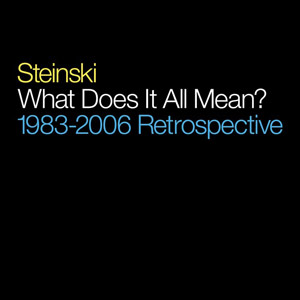
What Does it All Mean?
1983-2006 Restrospective
Illegal Art
In hindsight, it’s safe to assume that albums like 3 Feet High and Rising, Paul’s Boutique and Entroducing could not have been made without a 30-something ad exec that happened upon his “great idea” by accident. Entering Tommy Boy Records’ Hey Mr. DJ Play That Beat Down By Law Switch the Licks Mastermix contest back in 1983 was equivalent to a race to build an affordable electric car today. It was a simple task: remix a primitive rap track by G.L.O.B.E. and Whiz Kid, to be judged by (those now considered luminaries) Afrika Bambaaata, Shep Pettibone and John “Jellybean” Benitez (that dude who started Madonna’s career). Consequently it was an entry by a curious, dubious, white duo that won. Namely it was Steve Stein and Douglas Di Franco, composing what is now known as “The Lessons.” It changed the face of hip-hop forever.
Naysayers will immediately bring to the table John Oswald and his Plunderphonics manifesto as the formidable precedent to Steve Stein’s commercialist vision. That was written in 1985, and Oswald’s first track, “Power,” came in 1975 (a decade span of unbecoming). While he was certainly responsible for the anything-goes collage of found sounds, and Negativeland were the first to tackle the legal snafu of unlicensed samples, neither grafted that creativity onto the rudimentary structure of hip-hop. It was Steinski and Double-Dee’s first entry, “Lesson 1: The Payoff Mix,” that made sampledelica palatable, backing a barrage of recognizable ephemera with something danceable and universally popular.
Hip-hop started in the Bronx as something inherently danceable—the boasting of emcees over reconstituted, blown-out, disco tracks. Fortunately Steinski was tuned in to the current movement and reworked his entire catalog of records, the beat of the street and the aural history of public domain into a five-minute rollercoaster ride. “Lesson 1,” white-labeled as the “The Payoff Mix,” took what was already there (an 808 and Whiz Kid’s minimal skills), turned it inside out with a sizable amount of trills from the familiar hits from the day (Grandmaster Flash, Herbie Hancock, Sugarhill Gang) and spiked it with NASA’s mission control, Bogart’s quips right before lighting the match, the Supremes expounding post-war heartache, Art of Noise buzzsaw cuts, pre-war dance instruction and unstoppable breaks. For prosperity’s sake, it was the breaks that sold a generation. By digging up obscure rhythms from the Incredible Bongo Band, Dennis Coffey and most notably the James Brown, Steinski could very well be credited with inventing the break. Mixing beats may not have been cutting edge, but by splicing the day’s best records it became revolutionary. Forward to Lesson 3, “History of Hip-Hop,” and not only were the choicest sides from the emerging genres included, but Zeppelin’s “The Crunge” was officially added to hip-hop’s lexicon.Honestly though, listening over the Lessons, it’s easy to feel jaded. “What does it all mean?” Play that off in your head a few times. “What does it all mean?” You’ve heard it before. You’ve probably heard most of Steinski’s body of work before and that’s what’s become dated, simply because Steinski’s body of work became the template for hip-hop. The first disc is the curio cabinet of a vinyl time-traveler. Nothing is sacred, no samples are cleared; this is raw, public domain pillaging for the sake of juxtaposing dusty swing music, beatboxing, jazz scales and ’70s movie dialogue with mainstream radio deejays and mainstream media in general. Weaving this web, Steinski was not only manipulating hip-hop, he was providing social commentary that would be reiterated by other beat-centric plunder artists such as the Evolution Control Committee and in the highest regard, the Bomb Squad, who would go on to record Public Enemy’s repertoire. “The Motorcade Sped On” edits newsbites from the Kennedy assassination with Carson’s intro, the first chord of “Hard Day’s Night,” Prince grunts, Slick Rick, sirens, fake gunshots, Taps—this might be the first time someone coined the term “trippy” (check “Jazz” after a few bong hits). A more sobering “It’s Up To You (Television Mix)” reveals the regressive evolution of media distribution through time, mixing quotes from George Bush Sr.’s New World Order speeches into a thoughtful sonic discourse.
And that’s just within disc one (which is indispensable). Disc two, however, gives proof that Steinski is a card carrying member of the AARP. Still, the hour-long “Nothing to Fear: Rough Mix” that encompasses the second disc shows that Steinski’s playful spirit has been refined. The jittery, edit-every-10-seconds collage technique of his early mixes gives way to more fluid layering and a precise eye on scratching. Was it mentioned that Steinski had a huge influence on turntablism? Ever heard of the mash-up? Fitting that you can get this for cheap. Illegal Art, his conspirators in this retrospective, are also responsible for Girl Talk, the neo-Steinski that is willing to hurdle the challenge of unclearance to get everyone listening or at least dancing.Kevin J. Elliott
